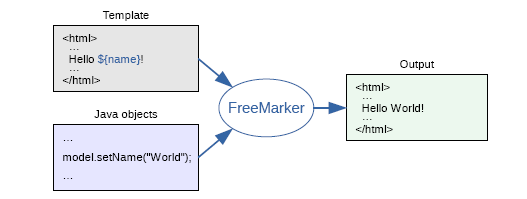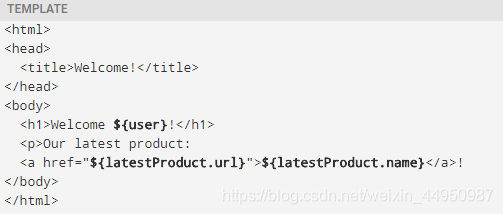FreeMarker 入门
FreeMarker介绍
freemarker是一个用Java开发的模板引擎


常用的java模板引擎还有哪些?
- Jsp
- Freemarker
- Thymeleaf
- Velocity 等
模板+数据模型=输出
freemarker并不关心数据的来源,只是根据模板的内容,将数据模型在模板中显示并输出文件(通常为html,也可以生成其它格式的文本文件)
1、数据模型
数据模型在java中可以是基本类型也可以List、Map、Pojo等复杂类型。
2、来自官方的例子:(https://freemarker.apache.org/docs/dgui_quickstart_basics.html)
数据模型:

模板:

输出:

FreeMarker快速入门
freemarker作为springmvc一种视图格式,默认情况下SpringMVC支持freemarker视图格式。
需要创建Spring Boot+Freemarker工程用于测试模板。
创建测试工程
创建一个test-freemarker 的测试工程专门用于freemarker的功能测试。
父工程指定了SpringBoot的版本
<?xml version="1.0" encoding="UTF-8"?>
<project xmlns="http://maven.apache.org/POM/4.0.0"
xmlns:xsi="http://www.w3.org/2001/XMLSchema-instance"
xsi:schemaLocation="http://maven.apache.org/POM/4.0.0 http://maven.apache.org/xsd/maven-4.0.0.xsd">
<parent>
<artifactId>shanjupay</artifactId>
<groupId>com.shanjupay</groupId>
<version>1.0-SNAPSHOT</version>
</parent>
<modelVersion>4.0.0</modelVersion>
<groupId>com.shanjupay</groupId>
<artifactId>test-freemarker</artifactId>
<dependencies>
<dependency>
<groupId>org.springframework.boot</groupId>
<artifactId>spring-boot-starter-freemarker</artifactId>
</dependency>
<dependency>
<groupId>org.springframework.boot</groupId>
<artifactId>spring-boot-starter-web</artifactId>
</dependency>
<dependency>
<groupId>org.projectlombok</groupId>
<artifactId>lombok</artifactId>
</dependency>
<dependency>
<groupId>com.squareup.okhttp3</groupId>
<artifactId>okhttp</artifactId>
</dependency>
<dependency>
<groupId>org.springframework.boot</groupId>
<artifactId>spring-boot-starter-test</artifactId>
</dependency>
<!-- https://mvnrepository.com/artifact/org.apache.commons/commons-io -->
<dependency>
<groupId>org.apache.commons</groupId>
<artifactId>commons-io</artifactId>
<version>1.3.2</version>
</dependency>
</dependencies>
</project>
test-freemarker工程 的pom继承父工程 pom,freemarker版本为2.3.28

配置文件
配置application.yml和 logback-spring.xml,从资料文件夹拷贝这两个文件,进行更改, logback-spring.xml无需更改,application.yml内容如下:
server:
port: 8088 #服务端口
servlet:
context-path: /test-freemarker
spring:
application:
name: test-freemarker #指定服务名
freemarker:
charset: UTF-8
content-type: text/html
suffix: .ftl
enabled: true
template-loader-path: classpath:/templates/
resources:
add-mappings: false #关闭工程中默认的资源处理
mvc:
throw-exception-if-no-handler-found: true #出现错误时直接抛出异常
创建模型类
在freemarker的测试工程下创建模型类型用于测试
package com.shanjupay.test.freemarker.model;
import lombok.Data;
import lombok.ToString;
import java.util.Date;
import java.util.List;
@Data
@ToString
public class Student {
private String name;//姓名
private int age;//年龄
private Date birthday;//生日
private Float money;//钱包
private List<Student> friends;//朋友列表
private Student bestFriend;//最好的朋友
}
创建模板
在 src/main/resources下创建templates,此目录为freemarker的默认模板存放目录。
在templates下创建模板文件test1.ftl,模板中的${name}最终会被freemarker替换成具体的数据。
<!DOCTYPE html>
<html>
<head>
<meta charset="utf-8">
<title>Hello World!</title>
</head>
<body>
Hello ${name}!
</body>
</html>
创建controller
创建Controller类,向Map中添加name,最后返回模板文件。
package com.shanjupay.test.freemarker.controller;
import org.springframework.beans.factory.annotation.Autowired;
import org.springframework.stereotype.Controller;
import org.springframework.web.bind.annotation.RequestMapping;
import org.springframework.web.client.RestTemplate;
import javax.servlet.http.HttpServletRequest;
import java.util.Map;
@Controller
public class FreemarkerController {
@Autowired
private RestTemplate restTemplate;
@RequestMapping("/test1")
public String freemarker(Map<String, Object> map, HttpServletRequest request) {
//向数据模型放数据
map.put("name", "world");
//返回模板文件名称
return "test1";
}
}
创建启动类
package com.shanjupay.test.freemarker;
import org.springframework.boot.SpringApplication;
import org.springframework.boot.autoconfigure.SpringBootApplication;
import org.springframework.context.annotation.Bean;
import org.springframework.web.client.RestTemplate;
@SpringBootApplication
public class FreemarkerTestApplication {
public static void main(String[] args) {
SpringApplication.run(FreemarkerTestApplication.class, args);
}
@Bean
public RestTemplate restTemplate() {
return new RestTemplate();
}
}
测试
请求:http://localhost:8088/test-freemarker/test1
屏幕显示:Hello world!

FreeMarker 基础指令
数据模型
Freemarker静态化依赖数据模型和模板,下边定义数据模型:
下边方法形参map即为freemarker静态化所需要的数据模型,在map中填充数据:
@RequestMapping("/test1")
public String freemarker(Map<String, Object> map, HttpServletRequest request) {
//向数据模型放数据
map.put("name", "world");
Student stu1 = new Student();
stu1.setName("小明");
stu1.setAge(18);
stu1.setMoney(1000.86f);
stu1.setBirthday(new Date());
Student stu2 = new Student();
stu2.setName("小红");
stu2.setMoney(200.1f);
stu2.setAge(19);
//stu2.setBirthday(new Date());
List<Student> friends = new ArrayList<>();
friends.add(stu1);
stu2.setFriends(friends);
stu2.setBestFriend(stu1);
List<Student> stus = new ArrayList<>();
stus.add(stu1);
stus.add(stu2);
//向数据模型放数据
map.put("stus", stus);
//准备map数据
HashMap<String, Student> stuMap = new HashMap<>();
stuMap.put("stu1", stu1);
stuMap.put("stu2", stu2);
//向数据模型放数据
map.put("stu1", stu1);
//向数据模型放数据
map.put("stuMap", stuMap);
//返回模板文件名称
return "test1";
}
List指令
本节定义freemarker模板,模板中使用freemarker的指令,关于freemarker的指令需要知道:
- 注释,即
<#‐‐和‐‐>,介于其之间的内容会被freemarker忽略 - 插值(
Interpolation):即${..}部分,freemarker会用真实的值代替${..} - FTL指令:和HTML标记类似,名字前加#予以区分,Freemarker会解析标签中的表达式或逻辑。
- 文本,仅文本信息,这些不是freemarker的注释、插值、FTL指令的内容会被freemarker忽略解析,直接输出内容。
在test1.ftl模板中使用list指令遍历数据模型中的数据:
<table>
<tr>
<td>序号</td>
<td>姓名</td>
<td>年龄</td>
<td>钱包</td>
</tr>
<#list stus as stu>
<tr>
<td>${stu_index + 1}</td>
<td>${stu.name}</td>
<td>${stu.age}</td>
<td>${stu.mondy}</td>
</tr>
</#list>
</table>
输出:
Hello world! 序号 姓名 年龄 钱包 1 小明 18 1,000.86 2 小红 19 200.1
说明:_index:得到循环的下标,使用方法是在stu后边加"_index",它的值是从0开始
遍历Map数据
1、数据模型
使用map指令遍历数据模型中的stuMap。
2、模板
输出stu1的学生信息:<br/>
姓名:${
stuMap['stu1'].name}<br/>
年龄:${
stuMap['stu1'].age}<br/>
输出stu1的学生信息:<br/>
姓名:${
stuMap.stu1.name}<br/>
年龄:${
stuMap.stu1.age}<br/>
遍历输出两个学生信息:<br/>
<table>
<tr>
<td>序号</td>
<td>姓名</td>
<td>年龄</td>
<td>钱包</td>
</tr>
<#list stuMap?keys as k>
<tr>
<td>${
k_index + 1}</td>
<td>${
stuMap[k].name}</td>
<td>${
stuMap[k].age}</td>
<td>${
stuMap[k].mondy}</td>
</tr>
</#list>
</table>
3、输出
输出stu1的学生信息:
姓名:小明
年龄:18
输出stu1的学生信息:
姓名:小明
年龄:18
遍历输出两个学生信息:
序号 姓名 年龄 钱包
1 小红 19 200.1
2 小明 18 1,000.86
if指令
if 指令即判断指令,是常用的FTL指令,freemarker在解析时遇到if会进行判断,条件为真则输出if中间的内容,否则跳过内容不再输出。
1、数据模型:
使用list指令中测试数据模型。
2、模板:
<table>
<tr>
<td>姓名</td>
<td>年龄</td>
<td>钱包</td>
</tr>
<#list stus as stu>
<tr>
<td <#if stu.name =='小明'>style="background:red;"</#if>>${
stu.name}</td>
<td>${
stu.age}</td>
<td>${
stu.mondy}</td>
</tr>
</#list>
</table>
通过阅读上边的代码,实现的功能是:如果姓名为“小明”则背景色显示为红色。
3、输出:
通过测试发现 姓名为小明的背景色为红色。
运算符
1、算数运算符 FreeMarker表达式中完全支持算术运算,FreeMarker支持的算术运算符包括:+, - , * , / , %
2、逻辑运算符 逻辑运算符有如下几个: 逻辑与:&& 逻辑或:|| 逻辑非:! 逻辑运算符只能作用于布尔值,否则将产生错误
3、比较运算符 表达式中支持的比较运算符有如下几个: 1 =或者==:判断两个值是否相等. 2 !=:判断两个值是否不等. 3 >或者gt:判断左边值是否大于右边值 4 >=或者gte:判断左边值是否大于等于右边值 5 <或者lt:判断左边值是否小于右边值 6 <=或者lte:判断左边值是否小于等于右边值
注意: =和!=可以用于字符串,数值和日期来比较是否相等,但=和!=两边必须是相同类型的值,否则会产生错误,而且FreeMarker是精确比较,“x”,"x ","X"是不等的.其它的运行符可以作用于数字和日期,但不能作用于字符串,大部分的时候,使用gt等字母运算符代替>会有更好的效果,因为 FreeMarker会把>解释成FTL标签的结束字符,当然,也可以使用括号来避免这种情况,如:<#if (x>y)>
空值处理
1、判断某变量是否存在使用 “??” 用法为:variable??,如果该变量存在,返回true,否则返回false
例:为防止stus为空报错可以加上判断如下:
<#if stus??>
<#list stus as stu>
......
</#list>
</#if>
2、缺失变量默认值使用 “!” 使用!要以指定一个默认值,当变量为空时显示默认值。
例: ${name!’’}表示如果name为空显示空字符串。
如果是嵌套对象则建议使用()括起来。
例: ${(stu.bestFriend.name)!’’}表示,如果stu或bestFriend或name为空默认显示空字符串。
内置对象
在freemarker中可以访问Request、Session等内置对象。
Request: 用于获取Request对象中的attribute对象。
Session:用于获取Session对象中的attribute对象。
RequestParameters:用于获取Request对象的parameter参数(浏览器端发送的请求数据)
1、配置
spring:
freemarker:
request-context-attribute: rc #把Spring的RequestContext对象暴露为变量rc
expose-request-attributes: true
expose-session-attributes: true
2、例子
1)在Controller中设置request、session的属性值
//测试内置对象
request.setAttribute("attr1", "test");
HttpSession session = request.getSession();
session.setAttribute("session1", "user1");
2)页面获取数据
url请求参数:${
RequestParameters['param1']!""}
request Attribute:${
Request["attr1"]!""}
session Attribute:${
Session["session1"]!""}
工程路径:${
rc.contextPath}
请求地址: ${
rc.requestUri}
附
完整的模板,上边测试的模板内容如下,可自行进行对照测试。
<!DOCTYPE html>
<html>
<head>
<meta charset="utf‐8">
<title>Hello World!</title>
</head>
<body>
Hello ${name}!
<br/>
<table>
<tr>
<td>序号</td>
<td>姓名</td>
<td>年龄</td>
<td>钱包</td>
</tr>
<#list stus as stu>
<tr>
<td>${stu_index + 1}</td>
<td <#if stu.name =='小明'>style="background:red;"</#if>>${stu.name}</td>
<td>${stu.age}</td>
<td>${stu.mondy}</td>
</tr>
</#list>
</table>
<br/><br/>
输出stu1的学生信息:<br/>
姓名:${stuMap['stu1'].name}<br/>
年龄:${stuMap['stu1'].age}<br/>
输出stu1的学生信息:<br/>
姓名:${stu1.name}<br/>
年龄:${stu1.age}<br/>
遍历输出两个学生信息:<br/>
<table>
<tr>
<td>序号</td>
<td>姓名</td>
<td>年龄</td>
<td>钱包</td>
</tr>
<#list stuMap?keys as k>
<tr>
<td>${k_index + 1}</td>
<td>${stuMap[k].name}</td>
<td>${stuMap[k].age}</td>
<td>${stuMap[k].mondy}</td>
</tr>
</#list>
</table>
</br>
<table>
<tr>
<td>姓名</td>
<td>年龄</td>
<td>出生日期</td>
<td>钱包</td>
<td>最好的朋友</td>
<td>朋友个数</td>
<td>朋友列表</td>
</tr>
<#if stus??>
<#list stus as stu>
<tr>
<td>${stu.name!''}</td>
<td>${stu.age}</td>
<td>${(stu.birthday?date)!''}</td>
<td>${stu.mondy}</td>
<td>${(stu.bestFriend.name)!''}</td>
<td>${(stu.friends?size)!0}</td>
<td>
<#if stu.friends??>
<#list stu.friends as firend>
${firend.name!''}<br/>
</#list>
</#if>
</td>
</tr>
</#list>
</#if>
</table>
<br/>
<#assign text="{
'bank':'工商银行','account':'10101920201920212'}" />
<#assign data=text?eval />
开户行:${data.bank} 账号:${data.account}
<br/>
url请求参数:${RequestParameters['param1']!""}<br/>
request Attribute:${Request["attr1"]!""}<br/>
session Attribute:${Session["session1"]!""}<br/>
工程路径:${rc.contextPath}<br/>
请求地址: ${rc.requestUri}<br/>
</body>
</html>
附 Spring Freemarker配置
spring.freemarker.allow-request-override=false # Set whether HttpServletRequest attributes are allowed to override (hide) controller generated model attributes of the same name.
spring.freemarker.allow-sessionoverride=false # Set whether HttpSession attributes are allowed to override (hide) controller generated model attributes of the same name.
spring.freemarker.cache=false # Enable template caching.
spring.freemarker.charset=UTF-8 # Template encoding.
spring.freemarker.check-template-location=true # Check that the templates location exists.
spring.freemarker.content-type=text/html # Content-Type value.
spring.freemarker.enabled=true # Enable MVC view resolution for this technology.
spring.freemarker.expose-request-attributes=false # Set whether all request attributes should be added to the model prior to merging with the template.
spring.freemarker.expose-session-attributes=false # Set whether all HttpSession attributes should be added to the model prior to merging with the template.
spring.freemarker.expose-spring-macro-helpers=true # Set whether to expose a RequestContext for use by Spring's macro library, under the name "springMacroRequestContext".
spring.freemarker.prefer-file-systemaccess=true # Prefer file system access for template loading. File system access enables hot detection of template changes.
spring.freemarker.prefix= # Prefix that gets prepended to view names when building a URL.
spring.freemarker.request-context-attribute= # Name of the RequestContext attribute for all views.
spring.freemarker.settings.*= # Well-known FreeMarker keys which will be passed to FreeMarker's Configuration.
spring.freemarker.suffix= # Suffix that gets appended to view names when building a URL.
spring.freemarker.template-loader-path=classpath:/templates/ # Comma-separated list of template paths.
spring.freemarker.view-names= # White list of view names that can be resolved.